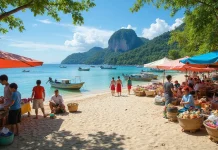Understanding Asia’s Colonial Era
The Onset of Colonialism in Asia
The colonial era in Asia was a period of significant transformation, beginning from the early 16th century and lasting until the mid-20th century. European powers arrived with the initial aim of expanding trade and subsequently established colonies. The desire for spices, silks, and other resources drove countries like Portugal, Britain, the Netherlands, France, and Spain to stake claims in various parts of Asia.
Legacy of Colonialism
These colonial powers left a profound impact on the region, not only altering its political landscape but also influencing its cultural, social, and architectural dimensions. Today, these colonial vestiges offer a unique lens through which explorers can understand Asia’s multifaceted history.
Historic Walking Tours in Southeast Asia
Singapore: A Confluence of Cultures
Walking through Singapore’s colonial district is like flipping through the pages of history. The island city-state, once a key British trading port, features iconic landmarks like Raffles Hotel, the Civic District, and the grandiose Supreme Court.
Raffles Hotel
Founded in 1887, Raffles Hotel is more than just lodging; it’s a symbol of opulence. Visitors can stroll through its historic halls, savor afternoon tea, or sip on a Singapore Sling, experiencing firsthand the luxurious tastes of colonial high society.
Civic District
The Civic District houses monumental buildings such as the Victoria Theatre and Concert Hall, the old Parliament House, and the National Gallery, which is home to Southeast Asian art treasures. Each building tells a story of Singapore’s journey from a British colony to a modern metropolis.
Vietnam: Echoes of French Indochina
Vietnam’s colonial past is primarily linked to French Indochina. The cities of Hanoi and Ho Chi Minh City (formerly Saigon) are indispensable stops for anyone interested in this era.
Hanoi
Walking through Hanoi’s Old Quarter and the French Quarter reveals a fusion of colonial French architecture merged with traditional Vietnamese elements. Iconic structures include the St. Joseph’s Cathedral and the Hanoi Opera House, both encapsulating the elegance of French design.
Ho Chi Minh City
In Ho Chi Minh City, the Central Post Office and Notre-Dame Cathedral Basilica vividly portray the French aesthetic. The Reunification Palace, while a symbol of Vietnam’s subsequent liberation, also reflects the complex narrative of its colonial history.
Malaysia: The Melaka and Penang Experience
Malaysia’s colonial journey is marked by Portuguese, Dutch, and British influences, with Melaka and Penang serving as immaculate examples.
Melaka
Melaka’s Red Square, a relic from the Dutch Era, is a vibrant starting point for discovering Malaysia’s colonial layers. The Stadthuys, Christ Church, and the A Famosa fortifications display a blend of Portuguese and Dutch architectural prowess.
Penang
Georgetown in Penang is a UNESCO World Heritage site, celebrated for its preserved colonial buildings. Highlights include the Pinang Peranakan Mansion, Fort Cornwallis, and Penang Hill, offering panoramic views of the colonial trade hub.
Walking Tours in South Asia
India: The Jewel in the Commonwealth
India was the crown jewel of the British Empire, with a rich colonial history leaving behind grand buildings and planned cities that still dazzle.
Kolkata
Once the capital of British India, Kolkata is rich in colonial architecture. Visitors can walk along Chowringhee Road, marvel at the Victoria Memorial, and explore the Indian Museum to gain insights into both colonial and indigenous histories.
Mumbai
Mumbai’s iconic Gateway of India and the Chhatrapati Shivaji Terminus bring colonial grandeur to life. These landmarks, alongside the bustling Colaba district, provide a vivid snapshot of colonial-era Mumbai.
Sri Lanka: Between Empires
The tiny island nation of Sri Lanka played host to the Portuguese, Dutch, and British empires.
Galle
The Galle Fort area, a UNESCO World Heritage site, merges these influences. Walking through its cobbled streets, one encounters the Dutch Reformed Church, the Old Dutch Hospital, and bastions offering mesmerizing sea views.
Colombo
Colombo’s Pettah Market and the Old Parliament Building are key sites. The city’s architecture reflects the layered tapestry of colonial governance and trade.
Colonial Walks in East Asia
Hong Kong: The Crown Colony
Hong Kong’s colonial imprints are ubiquitous, reflecting its status as a British colony from 1842 until 1997.
Central District
In the Central District, landmarks like the Legislative Council Building and St. John’s Cathedral are juxtaposed against modern skyscrapers, highlighting the colonial era’s lasting impact.
Tsim Sha Tsui
In Tsim Sha Tsui, travelers can follow in the footsteps of history at the former Kowloon-Canton Railway Clock Tower and the Peninsula Hotel, where colonial elegance meets contemporary luxury.
Shanghai: The Paris of the East
Shanghai’s colonial history bears the influence of numerous foreign powers during the concessions era.
The Bund
A stroll along The Bund offers a look at neoclassical buildings reminiscent of European styles. Landmarks include the Custom House and the iconic Gutzlaff Tower.
French Concession
The French Concession, with its tree-lined avenues such as Xinle Road and Fuxing Park, provides a charming escape into Shanghai’s colonial past.
Japan’s Unique Colonial Episodes
Nagasaki: Port of Diplomacy
Nagasaki’s history isn’t just marked by Japan’s own imperialism but also by Western influence due to its status as a trading port.
Glover Garden
The Glover Garden is a testament to Nagasaki’s international past, showcasing Western-style homes once occupied by foreign traders and diplomats.
Dejima Island
Dejima Island served as a gateway for Dutch and Portuguese merchants. Visitors can explore reconstructed buildings and learn about Japan’s sustained interactions with the West even during its isolationist policies.
Tracing the Leagues of Legacy
Urban Narratives Through Architecture
Exploring Asia’s colonial past through walking tours provides a unique perspective on how colonial powers influenced urban planning and architecture. These walks are an excellent way to witness firsthand the blend of western architectural styles with local adaptations.
Intertwined Cultural Influences
The colonial history of Asia is also a story of cultural exchange. While colonialism often brought about cultural imposition, there were also instances of syncretism, where new amalgamated traditions emerged.
The Modern Echoes of a Colonial Past
Economic and Political Footprints
Colonialism in Asia had long-lasting economic and political repercussions. Many present-day legal and educational systems in Asian countries were shaped significantly during colonial regimes.
Culinary Remnants
The fusion of culinary practices during colonial times has gifted Asia with distinctive flavors that continue to allure gourmets worldwide. Dishes such as Malaysian curries with a twist of Indian spice and the French influence on Vietnamese cuisine are lasting legacies of colonial culinary exchanges.
The Path Forward
While walking tours exploring Asia’s colonial past offer an introspective journey, they also implore modern-day observers to ponder the lessons of history, colonialism’s impacts, and the resilience of Asian cultures. The enduring landmarks stir dialogues about identity, sovereignty, and cultural preservation.
Every step on these ancient streets unveils stories of past grandeur, struggle, and transformation, allowing visitors to appreciate the tapestry of history that has shaped the vibrant Asia of today.































